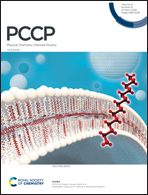Exploring fuel cell cathode materials using ab initio high throughput calculations and validation using carbon supported Pt alloy catalysts†
Abstract
We employ a combined density functional theory (DFT) and experimental approach to screen different elements (M) and Pt3M alloys (M = Sc, Y, V, Nb, Ta, Ti, Zr, Hf, Cr, Fe, Ru, Os, Co, Rh, Ir, Ni, Pd, Cu, Ag, Au and Al) for oxygen reduction reaction (ORR) activity and stability. The results of the calculations are validated using a series of carbon supported alloy nanoparticles measured within membrane electrode assembly (MEA) environments. We assess the reliability of descriptors such as surface d-band centre and O adsorption energy as computed from DFT calculations. We also assess the stability of the alloy surfaces under different adsorbate environments as encountered under ORR conditions. Our calculations predict that under an oxygen atmosphere segregation of M to the surface is likely to occur. The calculated segregation energies correlate reasonably well with the amount of base metal leached in the carbon-supported catalysts and good correlation of computed O adsorption energies with ORR activity is also shown.



 Please wait while we load your content...
Please wait while we load your content...